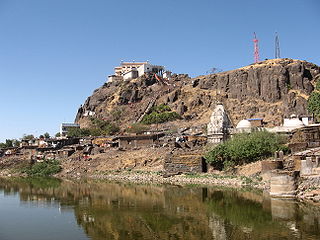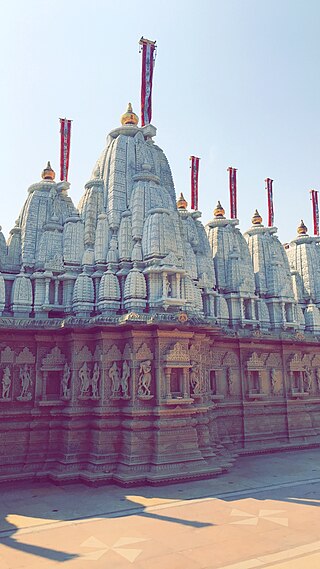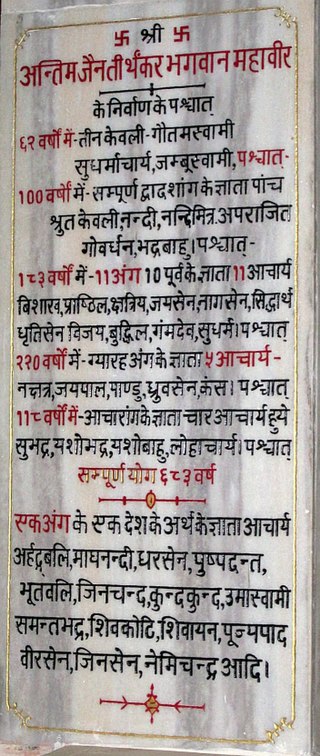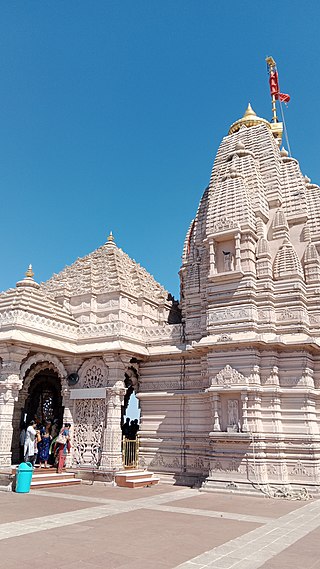
The Śvetāmbara is one of the two main branches of Jainism, the other being the Digambara. Śvetāmbara in Sanskrit means "white-clad", and refers to its ascetics' practice of wearing white clothes, which sets it apart from the Digambara or "sky-clad" Jains whose ascetic practitioners go nude. Śvetāmbaras do not believe that ascetics must practice nudity.

Girnar is an ancient hill in Junagadh, Gujarat, India. It is one of the holiest pilgrimages for Jains, where the 22nd Tirthaṅkar, Lord Neminath attained omniscience, and later nirvana along with other five hundred and thirty three enlightened sages. This is well described in ancient texts such as Kalpa Sūtra written by acharya Bhadrabāhu.

Pavagadh is a municipal operated region in Panchmahal district about 46 kilometres (29 mi) away from Vadodara in Gujarat state in western India. It is known for a famous Mahakali temple which is one of the 51 Shaktipeeths and draws thousands of pilgrims every day. However, as per records, this was originally a Jain temple belonging to the Svetambara Achalgaccha sect, whose Adhistayika Mahakali's idol was installed here in the 12th century. This locality Champaner-Pavagadh Archaeological Park was declared by UNESCO as a World Heritage Site in 2004.

Shankheshwar is a town in the Patan district of Gujarat state of India. It is an important place of pilgrimage for the followers of Jainism.

Siddhasenadivākarasuri was a Jain monk of the Śvetāmbara sect in the fifth century CE who wrote works on Jain philosophy and epistemology. He was like the illuminator of the Jain order and therefore came to be known as Divākara, "Sun". He is credited with the authorship of many books, most of which are not available. Sanmatitarka is the first major Jain work on logic written in Sanskrit. Among the most popular of his works, the Kalyan Mandir Stotra is a Sanskrit hymn dedicated to the 23rd Tirthankara Parshvanatha. It is one of the 9 holiest recitations in the Śvetāmbara Murtipujak sect of Jainism.

A Pattavali, Sthaviravali or Theravali, is a record of a spiritual lineage of heads of monastic orders. They are thus spiritual genealogies. It is generally presumed that two successive names are teacher and pupil. The term is applicable for all Indian religions, but is generally used for Jain monastic orders.

The Shankheshwar Jain Temple is located in the center of Shankheshwar town of Patan district, Gujarat, India. The temple is dedicated to Parshwanath and is an important place of pilgrimage for the followers of Jainism.

Godiji Parshwanath is the name given to several images of the Tirthankara Parshvanantha in India, and to the temple where it is the main deity (mulanayaka). Parshwanath was the 23rd Tirthankara who attained nirvana in 777 BCE. All these images and temples belong to the Śvetāmbara sect of Jainism.

Mahakali Mata Temple is a Hindu goddess temple complex and pilgrim centre at the summit of Pavagadh Hill in Panchmahal District, India, with in the Champaner-Pavagadh Archaeological Park.

Pavagadh Hill is situated within a plain in Panchmahal district, Gujarat, western India. A volcanic eruption occurred in the region approximately 500 million years ago and the etymology of Pavagadh is associated with this eruption: Pav-gadh means "one fourth hill" or "fire-hill". At its base is the historical city of Champaner, while the hill station of Pavagadh was built upon the volcanic cone itself. With Champaner, Pavagadh hill forms the Champaner-Pavagadh Archaeological Park, a UNESCO World Heritage Site which is spread over an area of more than 1,329 hectares. Known for its forts, there are also dozens of heritage structures on the hill. The site is 50 kilometres (31 mi) east of Vadodara and 68 kilometres (42 mi) south of Godhra.

The Palitana temples, often known only as Palitana, are a large complex of Jain temples located on Shatrunjaya hills near Palitana in Bhavnagar district, Gujarat, India. Also known as "Padliptapur of Kathiawad" in historic texts, the dense collection of almost 900 small shrines and large temples have led many to call Palitana the "city of temples". It is one of the most sacred sites of the Śvetāmbara tradition within Jainism. The earliest temples in the complex date as far back as the 11th century CE.

Jainism is an Indian religion which is traditionally believed to be propagated by twenty-four spiritual teachers known as tirthankara. Broadly, Jainism is divided into two major schools of thought, Digambara and Śvetāmbara. These are further divided into different sub-sects and traditions. While there are differences in practices, the core philosophy and main principles of each sect is the same.

Jain temples, Pavagadh is a group of seven Jain temples located in Pavagadh Hill in the state of Gujarat. These temples are part of the UNESCO World Heritage Site of Champaner-Pavagadh Archaeological Park.

Daulatsagarsuri was a Jain ascetic, philosopher, and a revered saint belonging to the Śvetāmbara sect. He was the head of the monastic order (Gacchadhipati) of the "Sagar Samudaay" of the Tapa Gaccha. While he was alive, he was the preceptor of 900 monks and nuns. He was awarded the rarest of the rare and ancient title of "Shri Sangh Sthavir" based on his austerity, knowledge of the canonical scriptures of Jainism, and spiritual leadership, becoming the only second of the modern Jain ascetics to have achieved this feat.
Upkeśa Gaccha is the oldest gaccha of Śvetāmbara Jainism. It is one of the 84 gacchas of the Śvetāmbara sect that were once in existence. Unlike most other gacchas that follow Mahavira's lineage and begin with his disciple Sudharmaswami, it follows the lineage of the 23rd Tirthankara Parshvanatha and is said to have begun with his prime disciple Ganadhara Shubhadatta. It went extinct in about 1930 CE.
Vādikavi Ācārya Bappabhattisuri Mahārāja Sāheb was a Śvetāmbara Jain ascetic in the 8th century CE. He was an eminent poet, philosopher, reformer, researcher, and a child prodigy. Apart from his literary contributions, he is best known for his scriptural debates and the reforms he brought about in the iconography of Tirthankara idols sculpted and owned by the Śvetāmbara sect of Jainism.

Aryarakshitsuri was Śvetāmbara Jain monk and the founder of the Achal Gaccha of the Śvetāmbara sect of Jainism. He was a contemporary of Hemchandrasuri and is said to have met him.

Antarikṣa Pārśvanātha Tīrtha is a Śvetāmbara Jain temple in Shirpur (Jain) town in Akola district, Maharashtra, India. Most popular for the main deity which is supposedly a 'floating' black-colored idol of Parshvanatha, the 23rd Tirthankara, this temple has been a center of devotion for Jains as well as of disputes between the Śvetāmbara and Digambara sect of Jainism. The main deity at this temple is one of the 108 most prominent idols of Pārśvanātha worshipped by Śvetāmbaras.
Achal Gaccha, also known as the Vidhipakṣa or Anchal Gaccha is one of the four existing Gacchas and one of the 84 gacchas of the Śvetāmbara Murtipujaka sect of Jainism. It was founded by Acharya Aryarakshitsuri in 1079 CE in response to the laxity that had crept into monasticism. Except for some minors differences, the rules and rituals of Achal Gaccha are similar to all the other existing gacchas of the Śvetāmbara Murtipujaka sect.


















